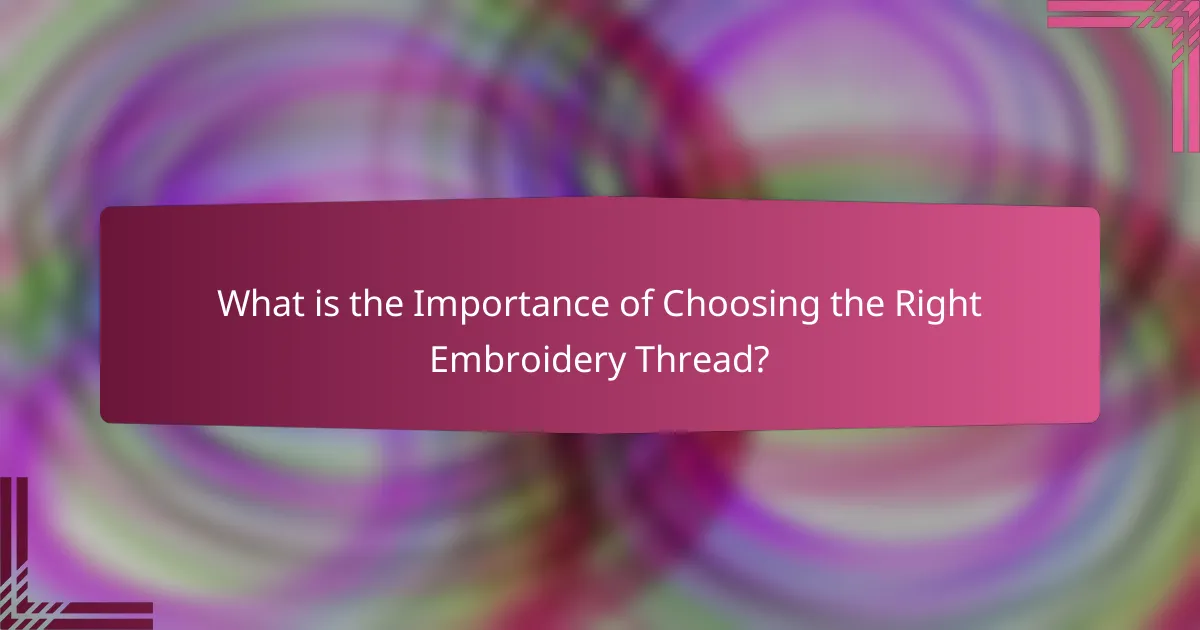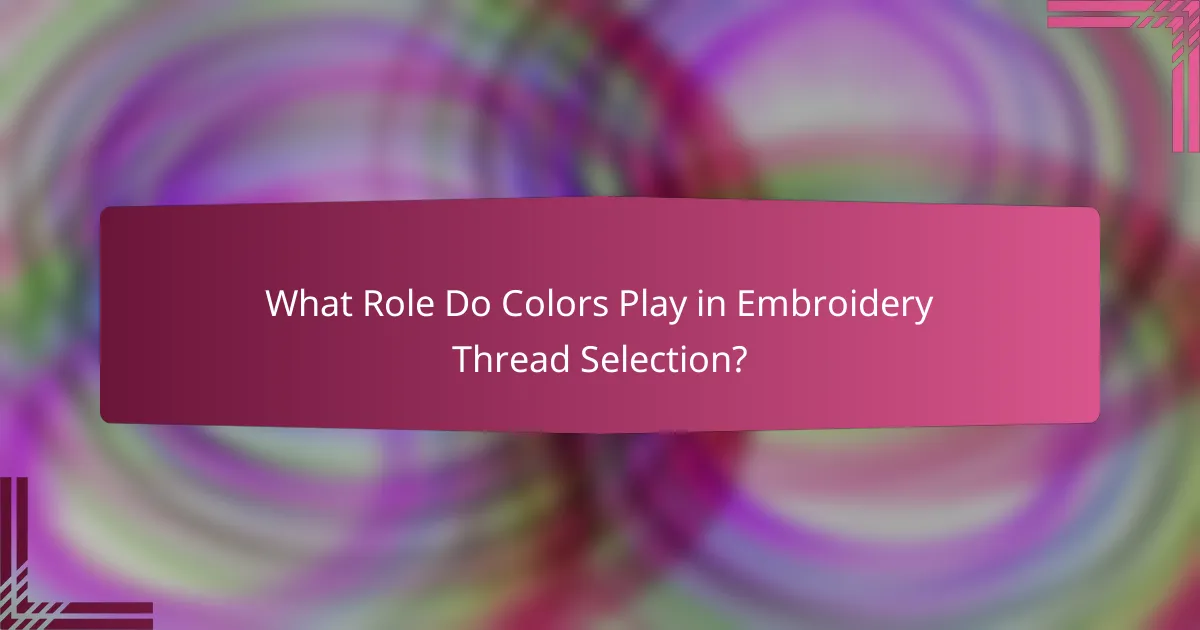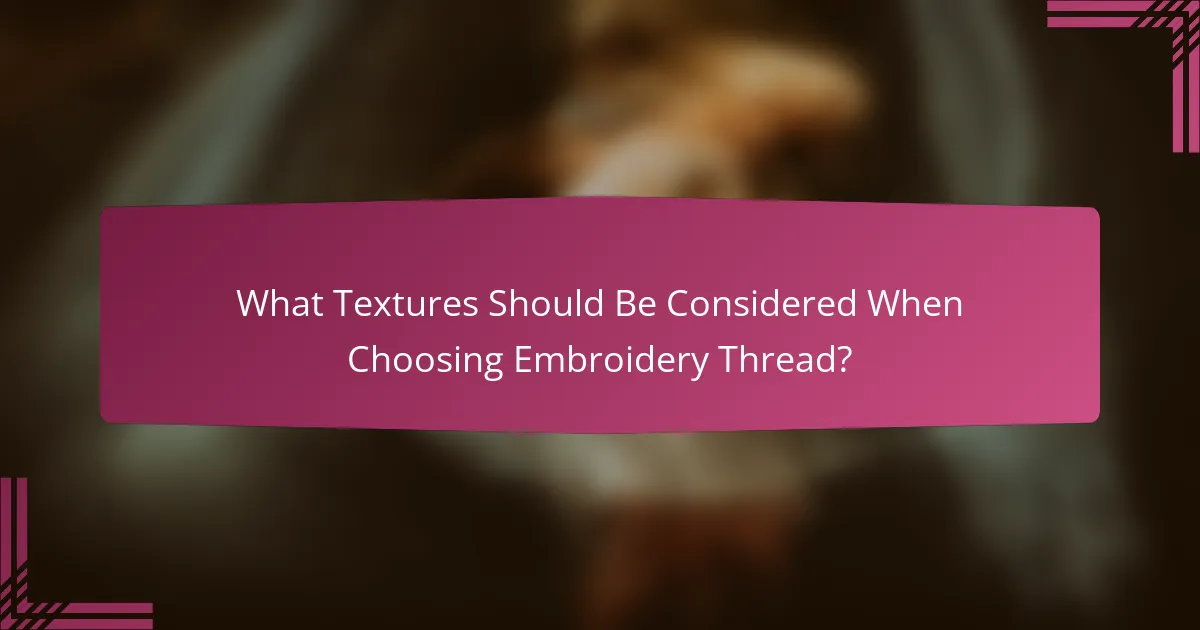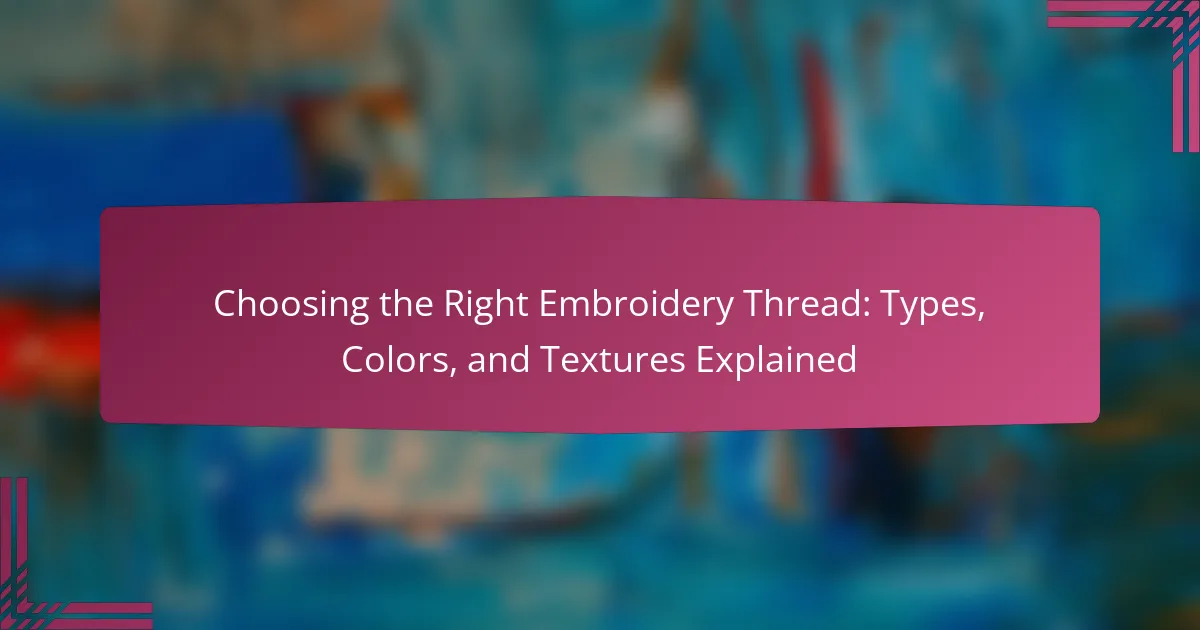
What is the Importance of Choosing the Right Embroidery Thread?
Choosing the right embroidery thread is crucial for achieving high-quality results. The appropriate thread enhances the overall appearance of the embroidery. It affects the durability and texture of the finished product. Different threads have varying levels of sheen, thickness, and strength. For instance, polyester threads offer excellent durability and colorfastness. Cotton threads provide a softer finish but may not be as strong. The choice of thread can influence the stitch definition and detail in the design. Using the wrong thread can lead to fraying, breakage, or fading. Therefore, selecting the right embroidery thread is essential for both aesthetics and functionality.
How does the choice of embroidery thread impact the final project?
The choice of embroidery thread significantly impacts the final project’s appearance and durability. Different threads have varying textures, colors, and thicknesses. For example, cotton thread offers a matte finish, while rayon provides a shiny look. The thickness of the thread affects the stitch density and overall design clarity. Using the wrong thread can lead to fraying or fading over time. Additionally, color selection influences the visual appeal and theme of the project. Choosing high-quality thread ensures better stitching results and longevity. Therefore, selecting the appropriate embroidery thread is crucial for achieving the desired outcome in any project.
What are the key factors to consider when selecting embroidery thread?
The key factors to consider when selecting embroidery thread include material, weight, color, and finish. Material affects the thread’s durability and appearance. Common materials are polyester, cotton, and rayon. Each material has unique properties; for instance, polyester is strong and colorfast. Weight determines the thickness and suitability for different projects. Standard weights include 40wt and 30wt, with lighter weights for fine detail. Color selection is crucial for achieving the desired aesthetic. Colorfastness is also important to prevent fading. Lastly, the finish can be matte or shiny, influencing the final look of the embroidery. These factors collectively ensure the embroidery meets quality and design expectations.
How does thread quality affect the durability of embroidery?
Thread quality significantly impacts the durability of embroidery. High-quality threads are made from stronger fibers, which resist fraying and breakage. This leads to longer-lasting embroidery designs. In contrast, low-quality threads can weaken over time, especially under tension or when exposed to washing. For example, polyester threads are often more durable than cotton threads due to their resistance to wear and fading. Additionally, high-quality threads maintain their color and texture better over time, ensuring that the embroidery looks fresh. Studies show that embroidery made with high-quality threads can withstand more washes without losing integrity. Thus, investing in quality thread enhances the overall durability of embroidery projects.
What types of embroidery threads are available?
There are several types of embroidery threads available. Common types include cotton, polyester, rayon, and silk threads. Cotton threads are popular for their durability and natural fibers. Polyester threads are known for their strength and resistance to fading. Rayon threads offer a shiny finish and vibrant colors. Silk threads provide a luxurious feel and are often used for high-end embroidery. Additionally, there are specialty threads like metallic and variegated threads that add unique effects to embroidery projects. Each type serves different purposes and preferences in embroidery work.
What are the differences between cotton, polyester, and rayon threads?
Cotton, polyester, and rayon threads differ in composition, durability, and appearance. Cotton threads are made from natural fibers, offering breathability and a soft finish. They are ideal for quilting and embroidery but can shrink and fade over time. Polyester threads consist of synthetic fibers, providing excellent strength and resistance to fading and shrinking. They are suitable for a wide range of fabrics and applications. Rayon threads are semi-synthetic, derived from wood pulp, and are known for their shiny, luxurious appearance. They are softer than polyester but less durable, making them best for decorative stitching. Each thread type has unique properties that influence their use in embroidery projects.
How do specialty threads enhance embroidery projects?
Specialty threads enhance embroidery projects by providing unique textures and visual effects. These threads can include metallic, variegated, or glow-in-the-dark options. Metallic threads add shimmer and shine, elevating the overall design. Variegated threads introduce color gradients, creating depth in the embroidery. Glow-in-the-dark threads offer an interactive element, making designs visible in low light. The use of specialty threads can also improve stitch definition and detail. This versatility allows for creative expression and customization in projects. Many embroiderers report increased satisfaction and visual appeal when using these threads.

What Role Do Colors Play in Embroidery Thread Selection?
Colors play a crucial role in embroidery thread selection. They influence the overall aesthetic and emotional impact of the finished design. The choice of colors can enhance visibility and contrast against the fabric. Specific colors can evoke different feelings and themes, such as warmth or coolness. Color harmony is essential for cohesive designs, often guided by color theory principles. Additionally, certain colors may be more suitable for specific projects or target audiences. For instance, bright colors may appeal to children, while muted tones may suit sophisticated designs. Ultimately, the right color selection can significantly elevate the quality and appeal of the embroidery.
How can color theory influence embroidery design?
Color theory significantly influences embroidery design by guiding color selection and combinations. It helps designers create visually appealing patterns. Understanding color relationships, such as complementary and analogous colors, enhances the overall aesthetic. For instance, complementary colors create contrast, making designs pop. Analogous colors provide harmony, resulting in a cohesive look. Additionally, color theory addresses emotional responses to colors. For example, warm colors evoke energy, while cool colors promote calmness. This understanding allows designers to convey specific moods through their embroidery. Ultimately, applying color theory leads to more effective and engaging embroidery designs.
What are the best practices for choosing colors that complement each other?
To choose colors that complement each other, use the color wheel as a guide. Complementary colors are opposite each other on the wheel. For example, blue and orange are complementary. Analogous colors, found next to each other, also work well together. Consider the 60-30-10 rule for balanced color distribution. This rule suggests using 60% of a dominant color, 30% of a secondary color, and 10% of an accent color. Test color combinations in natural lighting to see their true appearance. Utilize online color palette generators for inspiration and guidance. Lastly, consider the emotional impact of colors, as they can influence perception and mood.
How do colorfastness and fading affect thread selection?
Colorfastness and fading significantly influence thread selection in embroidery. Colorfastness refers to a thread’s ability to retain its color when exposed to various conditions. Threads that are not colorfast may fade quickly, leading to a less vibrant final product. Selecting colorfast threads ensures durability and longevity in the design. Fading can occur due to exposure to sunlight, washing, or friction. For example, polyester threads often exhibit better colorfastness compared to cotton threads. This is crucial for projects intended for outdoor use or frequent washing. Therefore, choosing threads with high colorfastness ratings is essential for maintaining the integrity of the embroidery over time.
What techniques exist for color matching in embroidery?
Techniques for color matching in embroidery include the use of color charts, digital color matching software, and physical thread samples. Color charts provide a visual reference for selecting thread colors that match the design. Digital color matching software allows for precise color selection based on RGB or HEX values. Physical thread samples enable tactile comparison and ensure color accuracy in different lighting conditions. These techniques help achieve consistent and accurate color representation in embroidery projects.
How can digital tools assist in color selection?
Digital tools assist in color selection by providing precise color matching and visualization capabilities. These tools offer color palettes and swatches that help users see how colors interact. Software can simulate embroidery effects, showing how colors will look on fabric. Many digital tools also allow users to upload images to extract colors directly. This feature ensures accurate color representation for specific projects. Additionally, some platforms provide color harmony suggestions based on design principles. This helps users create aesthetically pleasing combinations. Overall, digital tools streamline the color selection process, making it more efficient and accurate.
What are the benefits of using color swatches?
Color swatches provide a visual reference for selecting colors accurately. They help in ensuring color consistency across different materials. Using color swatches can enhance the decision-making process in design projects. This tool allows for quick comparison of various shades and tones. Color swatches also aid in communicating color choices with clients or team members. They can minimize misunderstandings regarding color preferences. Additionally, swatches can assist in predicting how colors will look when combined. This is crucial in embroidery, where thread colors can significantly affect the final appearance.

What Textures Should Be Considered When Choosing Embroidery Thread?
When choosing embroidery thread, consider the texture for compatibility with the fabric. Smooth threads glide easily through fabric, reducing snagging. Textured threads can add dimension and interest to designs. Additionally, matte threads absorb light, creating a subtle appearance. Conversely, shiny threads reflect light, enhancing visibility in designs. The choice of texture impacts the overall feel of the finished piece. Using the appropriate texture ensures the thread complements the fabric and design intent.
How do different thread textures affect the look and feel of embroidery?
Different thread textures significantly impact the look and feel of embroidery. Smooth threads create a sleek, polished appearance. They often result in a more refined finish, enhancing detail in intricate designs. Textured threads add depth and dimension to embroidery. They can create a more tactile experience, often making designs appear more vibrant and lively.
For instance, using a fluffy thread can give a raised effect, adding visual interest. In contrast, a shiny thread can reflect light differently, enhancing color vibrancy. Various textures also influence the drape and feel of the embroidered fabric. This diversity in thread textures allows for creative expression in embroidery projects.
What are the characteristics of smooth versus textured threads?
Smooth threads are characterized by a sleek, even surface that allows for minimal friction during stitching. This quality enables them to glide effortlessly through fabric. They produce clean, precise stitches and are ideal for detailed work. Textured threads, on the other hand, have a raised surface that adds dimension to the embroidery. This texture can create a more tactile and visually interesting finish. Textured threads are often used for decorative purposes, as they enhance the overall aesthetic of the embroidery. Both types serve different functions in embroidery, with smooth threads favored for precision and textured threads for artistic effects.
How can texture enhance the dimensionality of embroidery?
Texture enhances the dimensionality of embroidery by creating visual interest and depth. Different thread types, such as raised or fluffy textures, add layers to the design. This layering can make elements appear more three-dimensional. For example, using thick threads can create shadows and highlights. Additionally, varying textures within a single piece can draw attention to specific areas. Textured embroidery can also evoke tactile sensations, inviting touch. Research shows that textured designs are often perceived as more intricate and engaging. This perception can elevate the overall aesthetic of the embroidered piece.
What are the common challenges when selecting embroidery thread?
Common challenges when selecting embroidery thread include color matching, thread weight, and fiber type. Color matching is crucial for achieving desired aesthetics. Different fabrics reflect colors differently, complicating the selection process. Thread weight affects the thickness and overall appearance of the embroidery. Using the wrong weight can lead to uneven stitching. Fiber type influences the thread’s durability and sheen. For example, polyester offers strength, while cotton provides a matte finish. Additionally, compatibility with the embroidery machine is essential. Not all threads work well with every machine. Understanding these factors is key to successful thread selection.
How can thread tension issues be resolved?
Adjust the tension dial on the sewing machine to correct thread tension issues. Tighten the upper tension if the top thread is loose. Loosen the upper tension if the top thread is too tight. Check the bobbin case for proper installation and adjustment. Ensure the thread is correctly threaded through all guides and tension discs. Use the appropriate needle size for the thread type being used. Test different threads and fabrics to identify compatibility. Regular maintenance of the sewing machine can also prevent tension issues.
What troubleshooting tips can help with thread breakage?
To prevent thread breakage, ensure proper tension settings on the sewing machine. Incorrect tension can cause excessive strain on the thread. Regularly check the needle for damage or wear, as a dull needle can lead to breakage. Use the correct needle type for the thread and fabric being used. Ensure the thread is correctly threaded through all guides and tension discs. Keep the thread spool clean and free from dust or debris. Use high-quality thread, as inferior thread is more prone to breakage. Lastly, adjust the sewing speed; sewing too quickly can increase the likelihood of thread breakage.
What are the best practices for selecting embroidery thread?
Select embroidery thread based on material, weight, and color. Choose polyester or rayon for durability and sheen. Consider the thread weight to match the fabric and design. Use a color wheel to find complementary colors. Test thread on fabric before starting the project. Ensure the thread is compatible with the embroidery machine. Keep in mind the project’s purpose when selecting thread type. These practices enhance the quality and appearance of the final embroidery.
Choosing the right embroidery thread is essential for achieving high-quality results in embroidery projects. This article covers the importance of thread selection, detailing types such as cotton, polyester, and rayon, along with their unique attributes and applications. It also discusses key factors like color theory, thread textures, and quality, emphasizing how these elements influence the final appearance and durability of the embroidery. Additionally, practical tips for color matching and troubleshooting common challenges in thread selection are provided to enhance the overall effectiveness of embroidery work.
